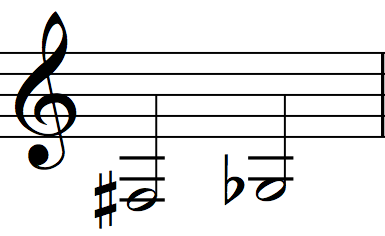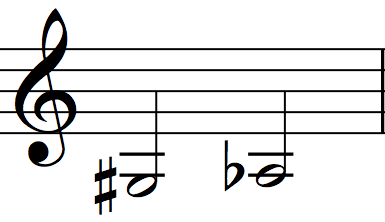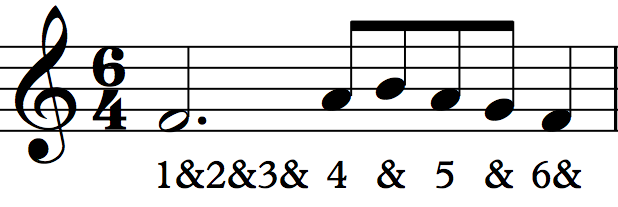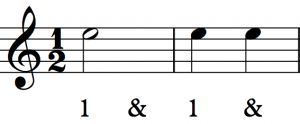15 More Notes & Meter
INTRODUCTION
In this unit you will learn more fretted notes on the sixth string and a few unique meters.
NOTATIONS
Notes
The Notes ‘F♯’ and ‘G♭’
‘F♯’ and ‘G♭’ are enharmonics. To play ‘F♯’ or ‘G♭’, fret the second fret on the sixth string.
The Notes ‘G♯’ and ‘A♭’
‘G♯’ and ‘A♭’ are enharmonics. To play ‘G♯’ or ‘A♭’, fret the fourth fret on the sixth string.
The Note ‘A’
You already learned to read this note as the open fifth string. However, this same pitch can be played as the fifth fret of the sixth string as well.
Meters
Meter with a Dotted Half Note Beat
The meter above is in compound duple. Each beat is equal to a dotted half note and is subdivided into three equal parts. Each subdivision is represented by a quarter note. It has the same feel as 6/8 meter. You can practice this meter in Capriccio.
Meter with a Half Note Beat
The meter above features three beats per measure. Each beat is represented by a half note. The half note beat often corresponds with a slower tempo. Further, half notes have the potential to be subdivided further than quarter notes. As a result, meters with a half note pulse often showcase highly-ornamented melodies, as is the case in European dance music from the Baroque era. You can practice this meter in Courante.
Old Meter
The meter above features one beat per measure. Each beat is a half note. This meter can apply to some European music from the Renaissance, but is rarely used today. You can practice this meter in Con qué la lavaré?
Mixed Meter

The example above is in mixed meter. A piece in mixed meter will feature two or more different time signatures in the same piece. New time signatures appear at the beginning of a measure. Subsequent measures continue in the previous time signature until a new time signature is introduced. You can practice this meter in Mark Popeney’s Brief Moments, After.
Complex Meter
Meters that do not fit into the duple, triple or quadruple metric groupings are referred to as complex. Often, the beats in complex meter are grouped asymmetrically.
The samaie (samai’i), from the Turko-Arab tradition, will serve as an example of complex meter. Its 10/8 time signature indicates ten subdivisions per measure. Notice how the composer breaks the 10 subdivisions into groups of 3+4+3 via dotted bar lines (from Unit 18’s Guitar Samaie). It is further implied that rhythmic emphasis should be placed on the first eighth note of each group. As a result, you will count either:
ONE, two, three, FOUR, five six, seven, EIGHT, nine, ten
ONE, two, three, ONE, two, three, four, ONE, two, three

Meter with Additive Rhythms
Meters with additive rhythms feature a time signature in which the top number can be broken into two or more asymmetrical beat groupings. Sometimes the top number of the time signature is written as an addition equation to reference the exact subdivisions.
Many musical traditions feature song forms in additive meter. Much of the world’s music was (and is) orally transmitted. Musicians in these traditions rely on memory and their knowledge of the style, not notation. A few of these traditions have recently adopted music notation. However, music notation often falls short of communicating the stylistic nuances of a tradition. If a piece is inspired by an oral musical tradition, I suggest you research its style, culture and form.
The paidushko, from the Balkan tradition will serve as an example of this phenomenon. Its 2+3/8 additive time signature indicates two pulses per measure, shown as sub-groups of 2 eighth notes + 3 eighth notes. You can practice this in Paidushko. Notice how the beaming patterns and placement of ornaments reinforce the 2+3 feel. As a result, you will count either:
ONE, two, THREE, four, five
ONE, two, ONE, two, three

Let’s Play |
Sight-Reading Tip
The meters introduced in this unit are not as complicated or challenging as they may appear at first glance. Many of them are associated with dances. A piece in mixed, additive or unusual meter can seem difficult when looking at its notation but is actually intuitive when you find its groove. Often a piece’s rhythmic logic just needs to get off the page and into the body. Before you start sight-reading a piece, spend time moving and singing with the groove of its meter.
Checklist for Sight-Reading
- Count the beats out loud (including the &).
- Keep going (even if you make a mistake).
- Maintain your best playing posture.
- Look at the score, not your hands.
- Play with the feel of the meter.
- Play patterns instead of individual notes (AKA chunk).
- Cultivate a calm demeanor.
- Have fun!
Let’s Play Rhythms |
Attitude Tip
The goal entices precisely because it eludes. —Peter Yates
Exercise 15.1: Score
Exercise 15.1: Audio
Exercise 15.2: Score
Exercise 15.2: Audio
Exercise 15.3: Score
Exercise 15.3: Audio
Exercise 15.4: Score
Exercise 15.4: Audio
Exercise 15.5: Score
Exercise 15.5: Audio
Let’s Play Patterns |
Attitude Tip
If you can’t fly then run, if you can’t run then walk, if you can’t walk then crawl, but whatever you do you have to keep moving forward. —Martin Luther King Jr.
Exercise 15.6: Score
Exercise 15.6: Audio
Exercise 15.7: Score
Exercise 15.7: Audio
Exercise 15.8: Score
Exercise 15.8: Audio
Let’s Play Duets |
Attitude Tip
Identifying the problem is half of the solution. When the goal is at hand, the method will appear. —Peter Yates
Air by Henry Purcell: Score
Air: Audio
from Invention in C Major by J.S. Bach: Score
from Invention in C Major: Audio
Capriccio by Johann Anton Logy: Score
Capriccio: Audio
Courante by François Couperin: Score
Courante: Audio
Paidushko: Score
Paidushko: Audio
Let’s Play Compositions |
These compositions are under the Creative Commons Attribution-NonCommercial 4.0 International License (CC BY-NC 4.0).
Attitude Tip
Watch your thoughts, they become words. Watch your words, they become actions. Watch your actions, they become habit. —Lao-Tzu
Obelisk No. 2 by Ashraf Fouad: Score
Obelisk No. 2: Audio
Obelisk No. 5 by Ashraf Fouad: Score
Obelisk No. 5: Audio
The Guitar 1 part of the next exercise was originally a vocal melody. Play the melody on the guitar first and then, if you want, sing it too.
Con qué la lavaré? by Miguel de Fuenllana: Score
Con qué la lavaré?: Audio
Congratulations!
You have completed this unit! If you kept up with the beat and accurately played approximately 70% of the pitches and rhythms, you are ready for the next unit. Feel free to repeat the exercises. However, do not play them so often that you memorize them. Once you memorize the notation, you are no longer developing the skill of sight-reading.







